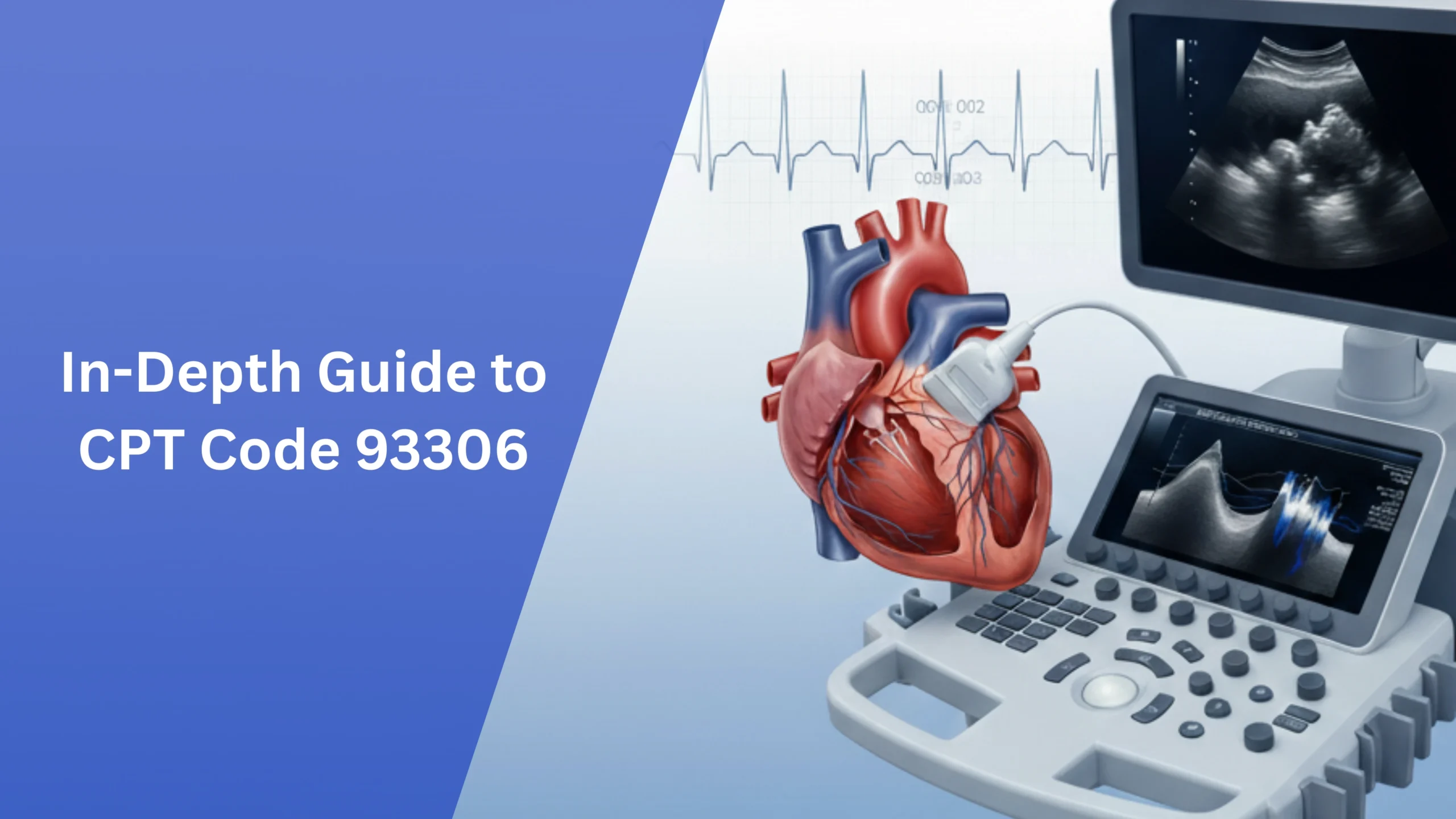Cardiology CPT codes are often complex and require careful interpretation to ensure accurate billing. In cardiology, precise coding is essential, as errors can lead to claim denials and delayed payments. Professional medical billing services play a crucial role in navigating these complexities and ensuring compliance with coding standards.
CPT 93306 is one of the most commonly used echocardiogram codes, and billers should know it well to get paid correctly. Since cardiology billing is one of the hardest areas of medical coding, getting clear on this one code could save practices time and money.
This article walks through what 93306 means, why it is important, and how it affects cardiology billing. Our goal is to demystify CPT 93306, helping your practice reduce errors and improve reimbursement. With proper coding of CPT 93306, the provider and billing team can focus on patient care instead of administrative issues.
93306 CPT Code Description
CPT 93306 is the billing code for a complete transthoracic echocardiogram that evaluates cardiac structure and hemodynamics. It describes a very elaborate diagnostic method that can see heart structures, functions, and flow patterns in detail. The healthcare providers and medical coders use the code to appropriately describe and bill for one of the most comprehensive cardiac imaging studies.
This code specifically designates a complete echocardiographic study, which includes two-dimensional imaging, M-mode recordings, and both spectral and color flow Doppler assessments. This distinguishes it from codes for limited or follow-up echocardiograms, which do not include all of these components.
What Is Included in CPT Code 93306 Echocardiogram?
CPT code 93306 refers to a complete transthoracic echocardiogram, which is a detailed and comprehensive cardiac imaging study. This code ensures that all essential diagnostic elements are included, such as two-dimensional real-time imaging, M-mode measurements, spectral Doppler evaluation, and color flow Doppler mapping. By covering these components, CPT 93306 provides a full picture of the heart’s structure, function, and blood flow dynamics, making it a cornerstone in both clinical cardiology and medical billing.
2D Real-Time Imaging (Included in CPT 93306)
Two-dimensional real-time imaging is one of the primary features included in CPT 93306. It allows the cardiologist to observe cardiac structures in motion, offering dynamic insights into ventricular contractility, wall motion abnormalities, and overall cardiac performance. This immediate, real-time visualization is especially critical for diagnosing conditions like heart failure, cardiomyopathy, and congenital structural abnormalities.
M-Mode Recording in CPT 93306
M-mode echocardiography, another integral part of CPT 93306, provides precise one-dimensional measurements of chamber dimensions, wall thickness, and valve motion over time. Although limited in imaging scope compared to 2D echo, M-mode is highly accurate in quantifying structural changes within the left ventricle, atria, and cardiac valves, making it essential for comprehensive cardiac assessment.
Spectral Doppler Assessment in CPT 93306
Spectral Doppler is included within CPT 93306 to measure blood flow velocities and calculate pressure gradients across cardiac valves and chambers. This component is indispensable for identifying stenotic valves, obstructed blood flow, and abnormal hemodynamic patterns. By quantifying flow disturbances, spectral Doppler enhances diagnostic accuracy and guides treatment decisions for patients with valvular or structural heart disease.
Color Flow Doppler in CPT 93306
Color flow Doppler completes the full echocardiographic study under CPT 93306. It provides a visual color-coded map of blood flow direction and velocity within the heart. This feature makes it easier to detect valvular regurgitation, stenosis severity, intracardiac shunts, and abnormal flow communications. The addition of color flow Doppler enhances both diagnostic precision and the cardiologist’s ability to evaluate the hemodynamic impact of cardiac abnormalities.
Indications and Clinical Uses of CPT Code 93306
Heart Murmurs Assessment
One of the leading indications under CPT code 93306 is in assessing heart murmurs. When patients have audible heart murmurs with physical examination findings, the full echocardiogram finds the causes behind, severity, and clinical implications of such acoustic findings. Thus, the comprehensive studies performed allow a cardiologist to distinguish between a harmless murmur and one caused by a structural heart defect.
Chest Pain Evaluation
For chest pain evaluation, CPT code 93306 provides comprehensive noninvasive assessment to identify potential cardiac etiologies. The procedure identifies wall motion abnormalities suggestive of coronary artery disease, pericardial effusions, or any other structural abnormality that might account for the patient’s symptoms.
Pre Operative Cardiac Evaluation
Before surgery, this heart test helps doctors understand any risks and plan safe treatment. In such thorough cardiac evaluations, surgeons and anesthesiologists choose the course of perioperative management and risk modification procedures to proceed with an informed decision.
Cardiac Structures Evaluated in CPT 93306
The complete transthoracic echocardiogram under CPT 93306 provides a detailed evaluation of multiple cardiac structures:
Heart Structure Analysis
This imaging procedure provides an extremely comprehensive assessment of cardiac anatomy, position, and overall morphology. A highly comprehensive assessment lets one identify congenital abnormalities, acquired diseases, and structural changes caused by various cardiac conditions.
Heart Chambers Assessment
Detailed evaluation of all four heart chambers is a fundamental component of the 93306 procedure. This includes measurement of chamber dimensions, assessment of wall thickness, and evaluation of contractile function in each cardiac chamber.
Right Ventricle Evaluation
Specific attention to the right ventricle is crucial for identifying pulmonary hypertension, right heart failure, and conditions affecting the pulmonary circulation. The comprehensive nature of CPT 93306 ensures thorough evaluation of right-sided cardiac function.
Left Ventricle Assessment
Left ventricular assessment is fundamental to the 93306 procedure, given its role in systemic circulation. This evaluation includes quantitative assessment of systolic function, regional wall motion analysis, and identification of myocardial abnormalities.
Heart Valves Examination
Comprehensive heart valves assessment is integral to CPT 93306, involving evaluation of all four cardiac valves for stenosis, regurgitation, and structural abnormalities. The combination of 2D imaging and Doppler studies provides detailed information about valve function and hemodynamics.
Blood Flow Patterns Analysis
Understanding blood flow patterns throughout the cardiac chambers and great vessels helps identify abnormal communications, such as septal defects, and assess the hemodynamic impact of various cardiac conditions.
Valve Dysfunction Detection
Valve dysfunction represents one of the most common findings during CPT 93306 procedures. The comprehensive nature of this study allows for:
- Measuring how much the heart valves are narrowed and how it affects blood flow
- Assessment of regurgitant severity using color and spectral Doppler
- Evaluation of valve morphology and structural integrity
- Hemodynamic assessment of the impact on cardiac function
Technical Aspects of CPT 93306 Echocardiogram
CPT 93306 is performed using a transthoracic echocardiographic approach, where an ultrasound transducer is placed on the chest wall. This non-invasive technique offers excellent visualization of cardiac structures while maintaining patient safety and comfort, making it the most common echocardiographic method in practice.
Modifier Guidelines for CPT 93306
Several modifiers may apply to CPT code 93306, depending on specific circumstances:
Modifier 26
Modifier 26 is used when the doctor reads the test results but doesn’t do the actual imaging.
Modifier TC
Modifier TC represents the technical component, applied when billing for the equipment, technologist time, and supplies without the physician interpretation.
Modifier 76
Modifier 76 indicates a repeat procedure by the same physician on the same day, which might occur if initial images are inadequate or if clinical circumstances change.
Modifier 77
Modifier 77 indicates a repeat procedure by a different physician, which might occur in teaching institutions or when coverage arrangements necessitate multiple physician involvement.
Modifier 52
Modifier 52 indicates reduced services when the complete procedure cannot be performed due to patient factors or clinical circumstances.
Modifier 53
Modifier 53 indicates discontinued procedures due to extenuating circumstances or patient safety concerns.
Healthcare Provider Roles in CPT 93306
The cardiologist is the primary physician responsible for interpreting studies performed under CPT code 93306. Their specialized expertise in cardiac imaging and hemodynamics ensures accurate evaluation of the heart’s structure and function, which directly informs diagnosis and treatment planning. While cardiologists typically provide the interpretation, the role of other physicians should not be overlooked. Primary care doctors, internists, and surgeons often order these studies to support broader patient management. In such cases, the results of a complete transthoracic echocardiogram (TTE) are integrated into overall clinical decision-making and care coordination.
Documentation Requirements for CPT 93306
Accurate documentation is essential to support claims billed under CPT 93306. A valid report must demonstrate that a complete echocardiographic study was performed, including:
- Comprehensive 2D imaging of all cardiac structures
- M-mode measurements where clinically indicated
- Spectral Doppler analysis of each cardiac valve
- Color flow Doppler evaluation to assess regurgitation and stenosis
- A clear interpretation that connects the imaging findings to the patient’s clinical condition
Without these elements, claims risk being denied for insufficient documentation. Proper reporting not only ensures compliance but also reflects the medical necessity of the test.
Reimbursement and Coding Considerations
Healthcare facilities and providers must ensure accurate coding and documentation to support appropriate reimbursement for CPT code 93306. This includes:
- Verifying medical necessity through appropriate clinical indications
- Ensuring complete study performance as defined by the code description
- Maintaining proper documentation to support the complexity of services provided
- Understanding payer-specific requirements and coverage policies
Conclusion
In this guide, we break down CPT code 93306 for a complete transthoracic echocardiogram (TTE). We have shared description and essential components, including 2D imaging, M-mode, spectral Doppler, and color flow Doppler. We also discussed the main clinical uses, such as chest pain evaluation, heart murmur assessment, and pre-operative cardiac screening. This makes CPT 93306 a cornerstone in both cardiology diagnostics and medical billing.
Moreover, we looked at some critical modifiers such as 26, TC, 76, 77, 52, and 53 to ensure proper claims and reimbursement. Accurate documentation and adherence to payer rules help reduce denials and strengthen revenue cycles. For clinics that find in-house billing difficult, outsourcing cardiology billing services provides reliable compliance and better financial outcomes.





